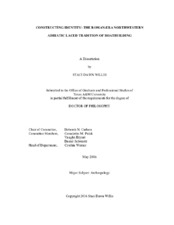| dc.description.abstract | This dissertation investigates the development of a local tradition of laced boatbuilding along the coasts and inland waterways of the northwestern Adriatic Sea during the Roman period (with definitive evidence between the second century B.C.E. and the sixth century C.E.). The primary focus of this research is to explore in particular how the preservation of this tradition reflects the existence of a local cultural identity for the community of builders in this region in the path of an expanding Roman presence as evidenced by changing material culture in the contemporaneous Mediterranean world. An environmental deterministic model has been proposed to explain the perseverance of the northwestern Adriatic laced tradition of boat-building; however, this model leaves several sociocultural and economic factors unexplored. This project is the first comprehensive study to contextualize northwestern Adriatic laced boats against the broader social, cultural, and economic background of the Mediterranean world and the local region, and to examine why a particular local boatbuilding tradition endured in a relatively small geographic region over an extended time period. It is the ultimate goal of this study to translate the technical aspects of the boat-building culture represented by northwestern Adriatic laced vessels into a broader discussion of the lifeways and identities of these ancient builders.
The decision-making strategies of the ancient builders are examined in regards to the materials used and techniques employed in the construction of these vessels, how these features changed across time, space, and/or function, and what factors might have affected the stability or dynamism of these material and structural aspects of the boat-building tradition Through this approach, I identify the stable features of the construction method that define the tradition as well as dynamic features that likely represent distinct builders or groups of builders within the broader community of practice. Understanding the decision-making strategies of the ancient builders of northwestern Adriatic laced vessels adds to our understanding of this local tradition of boatbuilding and provides an example of the nuanced experiences of various groups with the processes of Roman colonialism and subsequent cultural change. | en |


